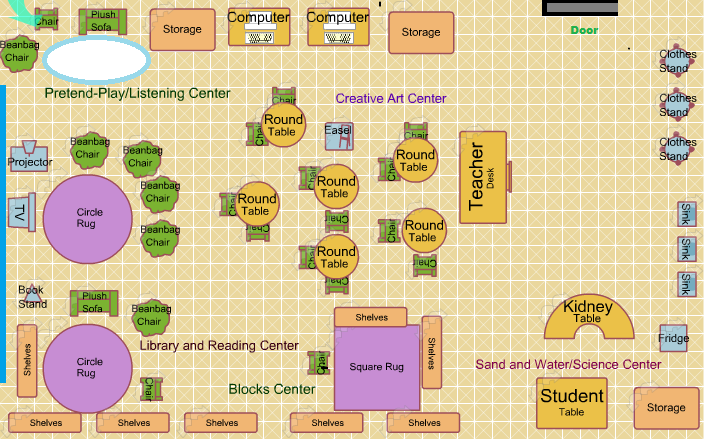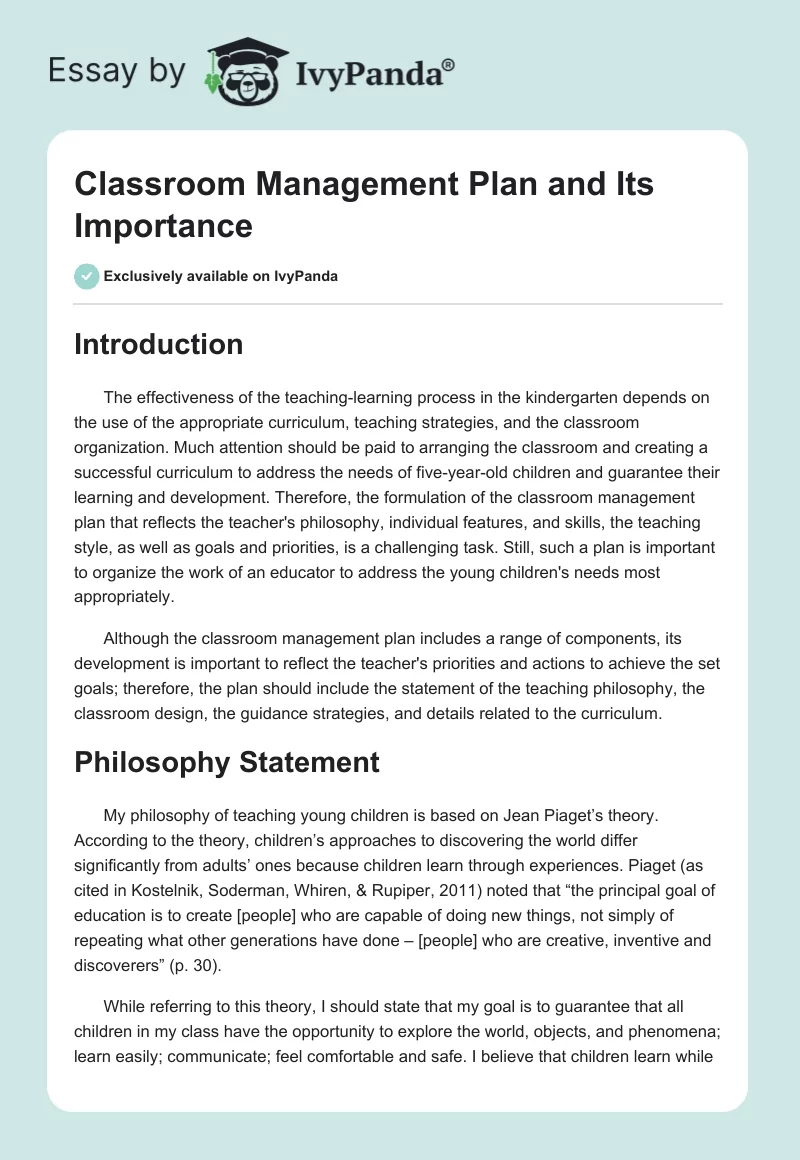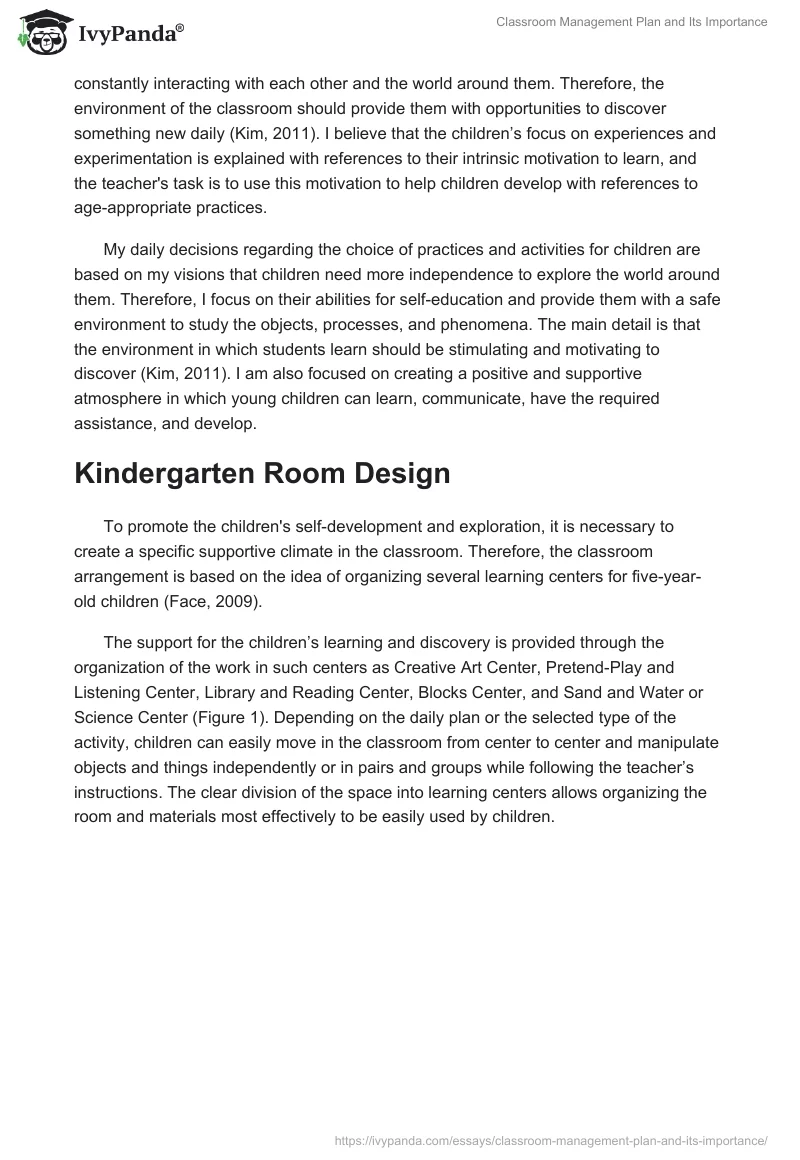Introduction
The effectiveness of the teaching-learning process in the kindergarten depends on the use of the appropriate curriculum, teaching strategies, and the classroom organization. Much attention should be paid to arranging the classroom and creating a successful curriculum to address the needs of five-year-old children and guarantee their learning and development. Therefore, the formulation of the classroom management plan that reflects the teacher’s philosophy, individual features, and skills, the teaching style, as well as goals and priorities, is a challenging task. Still, such a plan is important to organize the work of an educator to address the young children’s needs most appropriately.
Although the classroom management plan includes a range of components, its development is important to reflect the teacher’s priorities and actions to achieve the set goals; therefore, the plan should include the statement of the teaching philosophy, the classroom design, the guidance strategies, and details related to the curriculum.
Philosophy Statement
My philosophy of teaching young children is based on Jean Piaget’s theory. According to the theory, children’s approaches to discovering the world differ significantly from adults’ ones because children learn through experiences. Piaget (as cited in Kostelnik, Soderman, Whiren, & Rupiper, 2011) noted that “the principal goal of education is to create [people] who are capable of doing new things, not simply of repeating what other generations have done – [people] who are creative, inventive and discoverers” (p. 30).
While referring to this theory, I should state that my goal is to guarantee that all children in my class have the opportunity to explore the world, objects, and phenomena; learn easily; communicate; feel comfortable and safe. I believe that children learn while constantly interacting with each other and the world around them. Therefore, the environment of the classroom should provide them with opportunities to discover something new daily (Kim, 2011). I believe that the children’s focus on experiences and experimentation is explained with references to their intrinsic motivation to learn, and the teacher’s task is to use this motivation to help children develop with references to age-appropriate practices.
My daily decisions regarding the choice of practices and activities for children are based on my visions that children need more independence to explore the world around them. Therefore, I focus on their abilities for self-education and provide them with a safe environment to study the objects, processes, and phenomena. The main detail is that the environment in which students learn should be stimulating and motivating to discover (Kim, 2011). I am also focused on creating a positive and supportive atmosphere in which young children can learn, communicate, have the required assistance, and develop.
Kindergarten Room Design
To promote the children’s self-development and exploration, it is necessary to create a specific supportive climate in the classroom. Therefore, the classroom arrangement is based on the idea of organizing several learning centers for five-year-old children (Face, 2009).
The support for the children’s learning and discovery is provided through the organization of the work in such centers as Creative Art Center, Pretend-Play and Listening Center, Library and Reading Center, Blocks Center, and Sand and Water or Science Center (Figure 1). Depending on the daily plan or the selected type of the activity, children can easily move in the classroom from center to center and manipulate objects and things independently or in pairs and groups while following the teacher’s instructions. The clear division of the space into learning centers allows organizing the room and materials most effectively to be easily used by children.

The room is divided into seven areas that are identified and arranged according to their functions. The entrance is the first area where children can find clothes stands and wash hands. The next area nearby the sinks is Sand and Water or Science Center. This center is intentionally organized near sinks in order to supply children with all the necessary resources and help them maintain hygiene. This center is also equipped with tables having containers for sand and with the storages with tools (Bulunuz, 2013).
The central area of the room is equipped with round tables for students and the teacher table. This space is organized as a Creative Art Center where children can draw and use easels. Blocks Center is separated from the other room with the help of shelving units. All materials, large and small blocks, as well as figures of people, animals, and cars, can be found on these shelves. The next center is organized for reading.
There are many books with large illustrations in this center, and children can spend time there during their independent activities, and when the teacher reads books aloud. The next large zone is arranged for Pretend-Play and Listening Center. This area is equipped with carpets on which children play, storages for toys, the TV station, and the projector. There is also space for other technologies, such as computers.
While organizing the space, much attention is paid to guaranteeing that children can move in the room easily, and there is enough light in the classroom. There are many shelves on the walls without windows to provide children with more space. The proposed design of the room reflects the formulated philosophy directly because the arrangement guarantees that all children will be provided with materials and resources to become involved in activities that are interesting for them, and these activities can contribute to developing their experiences (Trivette, Dunst, Hamby, & Meter, 2012). Moreover, the centers work to ensure that all proposed activities are developmentally appropriate.
Children’s Physical and Psychological Safety and Guidance Strategies
The teacher’s expectations are based on the ideas that all children are respected in this classroom; their individual needs are met; their positive behaviors are encouraged. During this stage of their development, children need clear rules regarding their communication with each other and the teacher, as well as regarding activities. The behavior and guidance plan includes the following points:
- in this classroom, children respect each other and cooperate;
- we do not run in the classroom, only walk;
- all problems are solved with the help of words;
- children listen to the teacher’s words attentively;
- children follow the rules of the safe behaviors (Kostelnik et al., 2011).
The list including the main rules followed in the classroom should be presented by the teacher orally and in the written form with symbols understandable for children.
These formulated rules and strategies should be known not only to children but also to their parents, as well as teaching assistants, who can participate in the educational process. To ensure that all parents and other involved teachers are informed regarding these rules, they are printed in the form of a colorful brochure and presented on the stand in the classroom, as well as distributed with teacher notes and comments before the beginning of the year to all parents (Kim, 2011). Thus, these rules and principles should be communicated orally and in the written form.
Curriculum Model
The model that is the basis for the curriculum selected for five-year-old children is the Children’s Comprehensive Curriculum that includes six main domains. The proposed domains are the aesthetic, language, physical, social, affective, and cognitive ones (Kostelnik et al., 2011, p. 263). To speak about the complex development of a child, it is important to address these domains with references to the content and sequence of the curriculum. Activities related to developing all of these domains are expected to be included in the children’s daily schedules. For instance, on Monday, the planned activities include the work in Pretend-Play and Listening Center, as well as in the Library and Reading Center.
These activities are oriented to developing the children’s language, cognitive, and affective abilities, as well as the aesthetic vision. During this day, children can listen to music and share their emotions. On Tuesday, the planned activities can include the work in the Creative Art Center and Sand and Water or Science Center. Participating in these activities, children develop their aesthetic vision and cognitive abilities because they draw, work with sand, and create something new.
On Wednesday, for instance, the work in Pretend-Play Center and Blocks Center can be oriented to developing students’ social skills and contribute to their cognitive, affective, and physical development. Playing different roles, children develop their social skills (Trivette et al., 2012). In addition to planned tasks, children are also expected to choose the activities they want to participate in. The content of the curriculum is based on balancing the work in all centers while providing students with a lot of opportunities to select preferred tasks and work independently or in pairs to promote self-development. As a result of such an organization, the curriculum planning ensures following the goals and beliefs set in the philosophy statement.
Teaching Strategies and Procedures
The focus of the proposed curriculum is the student’s exploration of the world around him or her with references to individual and group activities. Moreover, much attention should be paid to utilizing strategies that allow the balanced development of a child according to six discussed domains. Therefore, the proposed teaching strategies include the work based on the self-development and cooperation, the work with different age-appropriate musical instruments, the work with blocks, the work with drawing materials, story-telling, retelling, playing different roles, the work with sand and water, and the work with computers among other approaches (Trivette et al., 2012). All these strategies are important to guarantee that a child develops all aspects of his or her personality.
While referring to the proposed curriculum and formulated philosophy, it is also necessary to provide examples of the teaching strategies that are expected to be actively used in this classroom. The first strategy is to organize the individual, pair, and group work depending on the activity in Pretend-Play and Listening Center, Blocks Center, and Sand and Water Center. The interaction during the work is important to develop students’ social skills. The second strategy is to organize the playing roles and story-telling to develop students’ language and social interaction skills, as well as skills in expressing emotions.
The language abilities also develop during these activities, and they can be enhanced with the help of reading aloud (Kostelnik et al., 2011). The third important strategy is to extend the students’ knowledge in the area of science while working in the associate center. The strategy connected with the third one is the use of children’s daily experiences to explain the scientific principles and phenomena in an age-appropriate manner. The next strategy is to help children categorize, classify, and group objects according to qualities (Face, 2009). Much attention should also be paid to using technologies as one of the teaching strategies. Thus, it is significant to encourage children’s listening to music, the work with projectors and whiteboards, as well as the participation in interactive games. These strategies are proposed to teach the domains’ content in the most appropriate manner that is oriented to five-year-old children.
Plan to Address Diversity in the Classroom
To meet the needs of diverse children and contribute to their learning and development, it is necessary to formulate the plan referring to the following goal: to ensure the learning and progress of all students in the class, regardless of their cultural background or developmental differences. The plan has a range of points to follow:
- the reading materials should include resources for children diverse in terms of languages they speak;
- the used video and audio materials should include the information regarding the various cultures, especially those that are represented in the class;
- the teacher should promote the cooperation between children belonging to different cultures or having special needs.
Also, it is important to include the culturally-specific information in the daily activities oriented to developing students’ cognitive, art, and social skills. Children need to learn about different cultures and traditions during their daily activities. Moreover, children need to develop their skills regarding the interaction with people having different needs, and the teacher’s task is to avoid developing stereotypes and promote tolerance in the class (Sherfinski, Weekley, & Mathew, 2015). Furthermore, the significant point of this plan is the cooperation with parents to invite them to the classroom and prepare the activities with children in order to demonstrate how it is important to help and support each other.
Conclusion
The classroom management plan developed for children who study in the kindergarten should be developmentally appropriate. While reflecting on the teacher’s priorities and goals, this plan is used actively to guide the daily activities of students to address their needs directly. Therefore, the effective plan includes the statement of the teaching philosophy formulated with references to the followed theory.
The plan also includes the discussion of the classroom design with the map and rationales for the selection of the space, furniture, and equipment. Moreover, it is also necessary to discuss the guidance strategies that are used by the teacher to coordinate the children’ behavior in the classroom. The plan should also include the details related to the curriculum and the teacher’s strategies used to educate children and to promote their cooperation while being involved in a culturally diverse environment.
References
Bulunuz, M. (2013). Teaching science through play in kindergarten: Does integrated play and science instruction build understanding? European Early Childhood Education Research Journal, 21(2), 226-249. Web.
Face, C. D. (2009). Block play: Practical suggestions for common dilemmas. Dimensions of Early Childhood, 37(1), 3-8. Web.
Kim, H. K. (2011). Developmentally Appropriate Practice (DAP) as defined and interpreted by early childhood pre-service teachers: Beliefs about DAP and influences of teacher education and field experience. SRATE Journal, 20(2), 12-22. Web.
Kostelnik, M., Soderman, A., Whiren, A., & Rupiper, M. (2011). Developmentally appropriate curriculum: Best practices in early childhood education. Upper Saddle River, NJ: Pearson. Web.
Sherfinski, M., Weekley, B. S., & Mathew, S. (2015). Reconceptualizing advocacy: Creating inclusive education in US universal pre-kindergarten. International Journal of Inclusive Education, 19(12), 1213-1228. Web.
Trivette, C. M., Dunst, C. J., Hamby, D. W., & Meter, D. (2012). Relationship between early childhood practitioner beliefs and the adoption of innovative and recommended practices. Research Brief, 6(1), 1-12. Web.


